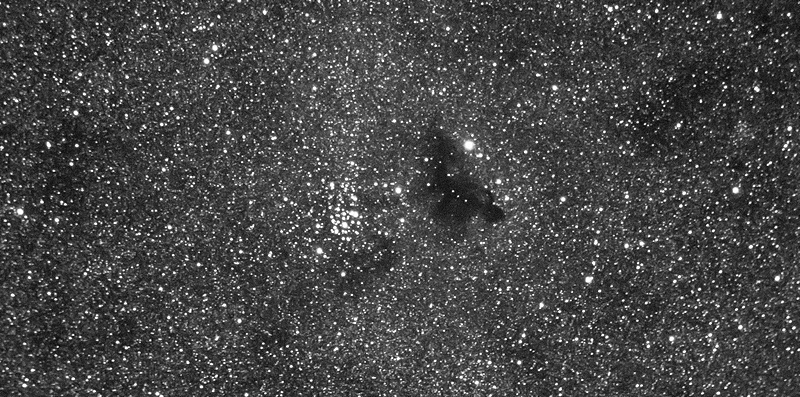Sunspots, Tiangong Space Station,
Ink Spot Nebula, Fireworks Galaxy, Knife Edge Galaxy
Posted: 7 September 2021
Sunday, 5 September 2021, was cloudy with surprise severe thunderstorms in the area in the late afternoon. Radar showed one of the severe storms (Flash Flood warned) approaching Oracle from the north with another storm to the southeast. I decided to put the Dome Cover ON.
View to North

View to Southeast

The storms missed Oracle, dropping only 0.04" rain here. But there was a lot of lightning and thunder. I managed to get this iPhone photo (video frame) through a window of one of the lightning bolts as the storm passed to the west. Later, my webcam captured another lightning bolt to the west.


Monday, 6 September, was mostly clear. There were four groups of sunspots on the Sun that were visible today. I decided to take a photograph of the Sun using my Nikon D850 DSLR with Tamron 150-600mm lens, but I discovered that the solar filter that fit my older Tamron 150-600mm G1 lens model would not fit the newer G2 model that I traded up to some months back. I'll have to get a different solar filter for that lens. I used my Nikon 70-300mm lens with a Spectrum Telescope 67mm solar filter. The image of the Sun was cropped from the full-frame image (see the inset for the scale) and was taken at f/8, 1/640sec, ISO 800, FL 300mm. Clockwise from the top are sunspots AR2864, AR2863, AR2868, and AR2866.


|
Open: Monday, 6 September 2021, 1807 MST Temperature: 81°F |
Session: 1660 Conditions: Clear |
Equipment:
12" f/8 LX600 w/StarLock
2" 24mm UWA eyepiece
2" UHC Filter
Camera:
iPhone 11 Pro Max
D850 DSLR
Upon arrival at the observatory I removed the Dome Cover. I opened the dome and then SYNCed the observatory clock to WWV. Finally I relaxed on the observatory patio bench for awhile.
1843 MST: sunset.
I planned to image the pass of the Chinese space station Tiangong with a crew of three later this night using the iPhone 11 Pro Max. I mounted the iPhone on a small tripod using the Levenhuk Smartphone Adapter and placed it on the POD Roller Desk.

1851 MST: LX600 ON, StarLock OFF, High Precision OFF.
Viewed Mercury, then Venus, 102X.
Prepared the D850 DSLR for prime focus imaging. Relaxed on the bench to wait the stars come out, always an enjoyable experience.
1944 MST: began setting up for the Tiangong pass. This is a 1 minute, 40 second exposure of the space station rising in the western sky. The Big Dipper is at the center and the bright star Arcturus at the left. The stars are slightly trailed but just to the left of the Tiangong trail mid-point is a non-trailed point of light. It was either a fast satellite flare or a meteor coming head on. The image was taken with NightCap Camera (ISS mode, 0.5X lens).

2005 MST: viewed NGC6520 (open star cluster) and the nearby Barnard 86 dark nebula (Ink Spot Nebula), 102X. Neat to see.
Mounted the D850 DSLR at prime focus + UHC filter, focused on the star Antares, and locked the 12" mirror. Slewed to NGC6520.
2014 MST: StarLock ON.
I then began doing StarLock autoguided images of my planned targets for this session. All images cropped.
NGC6520 & Barnard 86 (3 minutes, ISO 12800)

NGC6946 Fireworks Galaxy (stacked 20 minutes, ISO 12800)

NGC5907 Knife Edge Galaxy (stacked 25 minutes, ISO 12800)

2149 MST: StarLock OFF.
Viewed NGC5907 (Knife Edge Galaxy), then NGC6946 (Fireworks Galaxy), 102X.
2211 MST: viewed Saturn, 102X. Five moons were visible: Titan, Tethys, Enceladus, Dione, and Rhea. Then viewed Jupiter and the four Galilean Moons, 102X.
2214 MST: LX600 OFF.
2225 MST: took a sky quality reading, which was hampered by the high humidity. Reported the result to Globe at Night.
|
Close: Monday, 6 September 2021, 2230 MST Temperature: 75°F |
Session Length: 4h 23m Conditions: Clear, Humidity 49%, SQM 20.86 |
Comments are welcome using Email. Twitter users can use the button below to tweet this report to their followers. Thanks.
Cassiopeia Observatory Home Page
Copyright ©2021 Michael L. Weasner / mweasner@me.com
URL = http://www.weasner.com/co/Reports/2021/09/07/index.html
